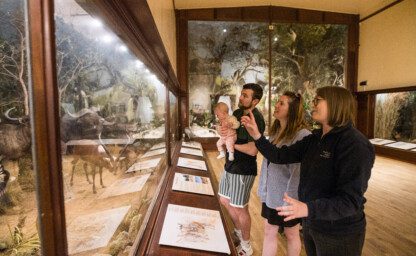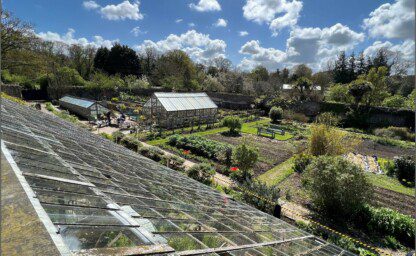Plan a visit
All the information you need to help you plan your day out with us.
Gallery 1 Home to the most recent dioramas (created from the 1930s onwards), this gallery is a showcase of mammal diversity and the taxidermist’s skill in recreating life-like poses. Three walls are taken up by a total of four different dioramas. Along the left wall, an African savannah landscape merges into a tropical forest, showing mammals of all sizes. In the central wall diorama, the diversity of African monkeys and Apes is shown. The right wall is split into two displays, with the smaller diorama showing a scene in an Indian Jungle, including our popular tiger, and the larger one showing African Desert animals.
Most of the animals in this gallery would not be found together in the wild. They were placed to show the differences and similarities between them
Gallery 2 Initially the only room of the museum, this gallery still contains a range of different collections. Trophy heads were typical for late-Victorian collections and were meant to prove the hunter’s prowess. The far right of the room is taken by the Kashmir diorama, the oldest in the museum, showing animals from the Himalayas.
Our stunning east-African collections (Ethiopian Art and Ugandan and Kenyan objects) are currently undergoing conservation work and reinterpretation, but some items are still on display in this gallery. We expect to complete the new exhibition displays in February 2025.
Gallery 3 Two sides of the room are taken up by dioramas of African animals, featuring enigmatic species such as Elephants, Giraffes, Rhinoceros and Lions, as well as a large variety of antelopes, smaller carnivores and other herbivores of all sizes. The popular lion and buffalo display in the centre of the gallery is popular with all visitors. Ask our team to learn the story behind this eye-catching display.
This Gallery also shows part of our beautiful textile collection, including historical and contemporary examples, and a small collection of (ethnographic) materials from southern African cultures.
Gallery 4 This Gallery focuses on the work of Diana and Tony (Antoinette) Powell-Cotton, who began working independently from their father, Percy, in the 1930s. The right half showcases their historical collection from the border region of Angola and Namibia, focussing especially on the lives of women and children. On the left, you will find our contemporary display of traditional Namibian clothing, jewellery and a doll, all specially commissioned for display. In the centre of the gallery, you can find out about the archaeological excavations Tony undertook in Minnis Bay- just a few minutes from the museum.
In the 1930s, it was rare for women to travel independently, as the sisters did. As women, they had access to different parts of society than their male colleagues would have had. The resulting collection is a valuable resource for researching this often-overlooked part of life
Gallery 5 This Gallery houses a wealth of material culture collections from northern and eastern Africa, including jewellery from the Maghreb (a region in north-western Africa, including Morocco, Tunisia, Algeria and Libya), bronze-work from the Kingdom of Benin (now part of Nigeria) and tools used by fishers on the Bajuni Islands (of the coast of Somalia). The collections here were acquired by Percy and Hannah Powell-Cotton, as well as their daughters Diana and Tony.
The collections in this gallery are supported by an impressive range of written records, photographs and even video recordings. They are housed in our archive, but some of them can be seen alongside the objects. You can find out how they can be used for research by reading about our Somali Photo Archive.
Gallery 7 This gallery is a 2-in-1, showing beautiful Chinese and Japanese ceramics as well as telling the history of life at Quex.
Chinese porcelain was popular around the world because it was especially fine, and the craftsmen were exceptionally skilled. Percy Powell-Cotton travelled to Japan and China on his world trip, and you can read about some of his experiences, accompanied by photos from our archive.
In the second half of the gallery, you can read about the different families that owned the Quex estate, how they changed it, and where you can still see their influence. Please note that Gallery 7 is temporarily closed to provide storage for objects as part of a large conservation project. A small display outlining the project is available to view.
Gallery 8 In the late 19th and early 20th century, many Europeans travelled far from home, taking Christianity and their view of (western) civilisation to non-Christian communities. This gallery shows items collected by Florence Coombe, who worked as a British missionary on islands in the South Pacific. Florence began her career as a children’s author but joined the Melanesian Mission in 1905, when she was stationed in Norfolk Island as a teacher in one of the many mission-run schools. Florence wrote four books about her time in Melanesia as a missionary. Her collection came to the museum via a donation from Robert Walker, an associate of Florence, whose son donated over 400 objects to the museum following his father’s death.

All the information you need to help you plan your day out with us.

For the latest news, events and open days.